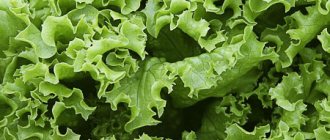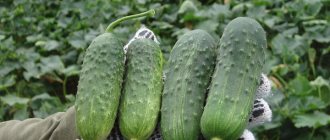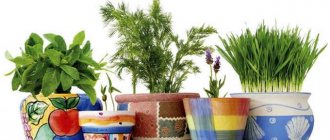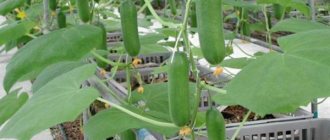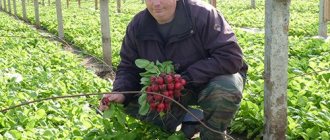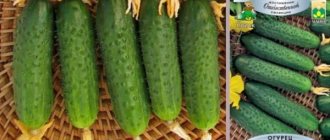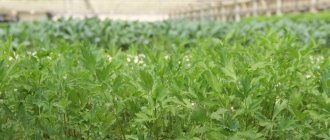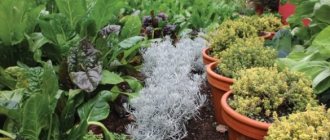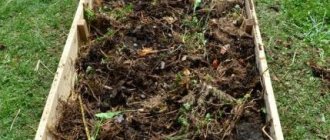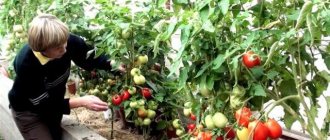Metal profile frame
First, arched arcs are installed from one end of the polycarbonate winter greenhouse to the opposite wall. Each part is leveled and attached to the base beam.
Then the upper and lower guides are screwed or welded to the arches. This creates strength and stability of the structure.
Secure the polycarbonate using thermal washers and self-tapping screws. The fittings should not be tightened too tightly, and the polycarbonate sheets should not bend.
There is an easy way to attach a polycarbonate sheet to the end of a future greenhouse. It is necessary to cut a square with sides equal in length to the bottom of the greenhouse. Then attach the sheet to the end and carefully cut off the excess polycarbonate along the edges.
Construction of a year-round mixed greenhouse
Layout of the greenhouse location on the site.
A mixed-type do-it-yourself greenhouse assumes that the walls will be built from foam blocks or other similar materials, and the roof will be transparent, that is, made of glass or polycarbonate. Of course, it is best to use polycarbonate, since it is quite possible to install it yourself. First of all, you need to make a foundation. A strip foundation buried 50-75 cm is perfect for such a light structure. To carry out further construction of the greenhouse, it is necessary that the foundation stands for at least 3 months.
Next, the walls are constructed from foam blocks. The height of the walls must be at least 1.7 m so that you can move around in the greenhouse without difficulty. The walls on the inside and outside should be plastered. Next, you can begin to form a transparent roof. First, rafters are formed from a metal profile. After forming a strong frame, you can move on to attaching polycarbonate, which in this case needs to be fixed in a special way.
First, the first layer of polycarbonate sheets is attached to the existing rafters. Next, metal profiles are attached on top of this layer, onto which, in turn, a second layer of polycarbonate sheets is fixed.
The heat loss of such a roof will be minimal, so the snow will not melt on it, which means you should make a ridge with a large angle so that you can clear snow from the roof if necessary. After laying the polycarbonate, the joint on the outside is covered with a transparent plastic ridge, and on the inside, the ridge area and all areas located in the gap between the wall and the roof are carefully sealed with polyurethane foam. When forming this type of greenhouse, the interior decoration is very important, and approximately 1 m of the lower part of the greenhouse walls is covered with foil insulating film, and the upper part of the walls is painted white, which repels light.
The idea of an eco-greenhouse and its structure
Now let’s move on to the description of the ecogreenhouse and find out which of the permaculture ideas it intersects with. The main feature of the building is that it is combined with a chicken coop. These birds are distinguished by a very high body temperature of + 40°C. And if you equip them with a separate room for living and connect it with ventilation to the greenhouse, then warm air with a high content of carbon dioxide and ammonia will flow into the latter, which will have a positive effect on the condition of the plants.
Features of the ecogreenhouse
Additional heating of the eco-greenhouse is carried out using heat accumulators. In the simplest version, these are containers with water or stones, placed in the same room with plants under the rays of the sun penetrating through polycarbonate, glass or film. During the day, the battery heats up and stores energy. At night, when the sun goes down and the outside temperature decreases, these stones or water give off heat and thus warm the soil and the crops growing on it.
Design example
In addition to producing heat and carbon dioxide, chickens in eco-greenhouses perform other tasks:
- production of eggs and their shells - natural fertilizer;
- production of manure - one of the components of compost;
- pest control on open ground - chickens eat insects;
- natural cultivation of open ground - chickens rake it in search of food.
One example of the use of permaculture technologies is the “chicken tractor” - a portable home for birds that is transported through vegetable gardens or fields. Chickens, looking for insects, loosen the soil and destroy pests, feeding along the way
The diagram shows the interaction of some of the components of a permaculture site.
Compost produced using chicken manure also finds its way into the ecogreenhouse as fertilizer for the garden beds and another natural source of heat for the soil. As for water, in such greenhouses it reaches the plants through drip hoses. At the same time, it partially accumulates due to precipitation in open containers equipped with filters.
Characteristics of popular crops
What is profitable to grow in a greenhouse all year round? Flowers, tomatoes, cucumbers and other vegetables, herbs or strawberries are most often grown in a greenhouse. Let's look at this in more detail.
- Flowers. The most popular option for farmers is hybrid roses. They are in stable demand and are not too demanding on living conditions. High-quality planting material, timely watering and fertilizers are required. You can cut up to 250 flowers from one rose bush per year. Chrysanthemums, various potted crops, hanging arrangements of annuals and flower seedlings are successfully grown in greenhouses.
- Greenery. It is possible to grow green onions, parsley, dill, lettuce, cilantro, and a variety of aromatic herbs. The most cost-effective option is to grow greens in peat pots, in which they are sold. Such greens are stored longer, the markup on them is higher, and consumer demand is stable at any time of the year.
- Tomatoes and cucumbers. Profitability is average, very dependent on the season. It is more profitable to grow vegetables using hydroponic technology in containers with a nutrient solution. The method shortens the growing season, but worsens the taste and the tomatoes turn out watery. Ground vegetables are much tastier, but keeping them in a greenhouse is more expensive. Tomatoes and cucumbers are demanding on soil composition and watering.
- Other vegetables. Heat-loving crops are often grown in greenhouses: eggplants, zucchini, sweet and hot peppers. To shorten the growing season, it is recommended to plant seedlings in a greenhouse. Vegetables require frequent replacement of soil and fertilizers and are well stored and transported.
- Strawberry. In demand throughout the year. It is more profitable to grow berries using the hanging Dutch technology, which saves space in the greenhouse. Strawberries do not tolerate transportation well.
IMPORTANT! You need to choose varieties cultivated for indoor soil, characterized by a rich taste and the correct shape of the berries, as well as their density and moderate juiciness.
Advantages and disadvantages
Before construction begins, a diagram for construction should be developed. If you plan to grow a winter garden, then you need a certain temperature regime, thanks to which it will be possible to grow tropical plants. For any structure, if it is created with your own hands, a solid foundation and a reliable frame are required.
Greenhouses intended for use all year round have their advantages and disadvantages:
- in a trench greenhouse, vegetables and fruits are grown all year round;
- the underground structure is characterized by cool temperatures on a hot day, which is necessary for most plants;
- these types of structures can be made independently using a diagram or drawing;
- have a low cost - during construction you can use budget building and finishing materials.
Particularly popular are hangar models covered with polycarbonate – this is evidenced by reviews from the owners.
Such greenhouses have many advantages:
- low cost;
- ease of assembly;
- excellent protection from snow and rain;
- plants receive the maximum amount of light.
Polycarbonate for building a greenhouse has excellent thermal insulation properties, it is very flexible, which allows it to be used for an arched greenhouse. Polycarbonate is a very light material - it is 16 times lighter than glass.
Metal-plastic can also be used for construction. Although independently constructing a metal-plastic greenhouse is not an easy task, they usually resort to the services of specialists for this. For such structures, it is better to make the frame to order - the result may not be a very profitable building in financial terms.
Installation of transparent greenhouses for use all year round
Scheme of a greenhouse with a metal frame.
Since polycarbonate greenhouses are most popular due to their practicality, it is worth considering the construction of a year-round transparent greenhouse using this material as an example. If you plan to grow vegetables and herbs in a greenhouse during the cold season, it is necessary to plan the greenhouse so that it stands on a foundation and in the future it is planned to place boxes with soil in it, since the cost of heating the ground, as a rule, is not justified. In this case, it is best to do internal heating based on heating elements or infrared lamps, but more on that later.
So, it becomes clear that a year-round polycarbonate greenhouse is a rather complex structure, which involves the construction of at least a minimal foundation, and in addition, double walls and a roof. When carrying out the work you will need the following materials and tools:
A greenhouse built from aluminum will last much longer than its wooden or plastic counterparts.
- foam blocks;
- concrete;
- insulation materials;
- steel pipes for frame
- sheets of cellular polycarbonate;
- mounting elements (thermal washers, self-adhesive, self-tapping screws, etc.);
- shovel;
- Circular Saw;
- facing materials, etc.
It is recommended to install a polycarbonate winter greenhouse on a foundation. In this case, it is not necessary to form a really strong foundation like for a building, since the foundation will be used to support a very light structure. To form the foundation for the greenhouse, you first need to dig a 50-centimeter pit. In order for the pit site to be as level as possible, you need to constantly check the level. Further along the perimeter, where the walls of the greenhouse will be located in the future, a foundation base is formed from foam blocks held together with cement mortar.
It is very important that the height of the foam block base is at least 10 cm above the ground level. Next, you need to arrange the base for the future floor, for this, first put a pie of 20 cm of sand, 25 cm of pebbles or crushed stone on the bottom. The floor of the greenhouse can be poured with concrete and covered with tiles. After all the preparation work has been completed, you can begin installing the frame. It is worth noting that a steel frame is best suited for a year-round greenhouse, as it has sufficient rigidity for the greenhouse to easily survive possible heavy snowfalls. If it is not possible to purchase a ready-made frame, it can be welded from old steel pipes.
Block greenhouse
Year-round greenhouse
A block year-round greenhouse is built as nearby gable or arched structures that touch each other on the sides. At the junction it is necessary to make several support posts that can replace the wall. As a result, you can reduce the financial costs of building a greenhouse, but at the same time make a very impressive and functional structure that will serve for a long time if assembled correctly. The roof can also consist of several sections rather than one. Several gutters are also made in it to drain water that can accumulate during heavy rainfall.
The size of the greenhouses, their length can be absolutely any, and it all depends on how much planting the gardener will do in the greenhouse, and for what purpose they do it - for personal cultivation of crops, or for more extensive industrial production of goods. You can cover the greenhouse with the good old and well-known polycarbonate or glass. Film or any other agronomic material can also be used - it all depends on the degree of financial security of the gardener and on what materials will be most available to him in a particular period of time.
Block greenhouses have a number of advantages over any other types of greenhouses. These benefits include the following:
- the design turns out to be the most financially economical when compared with any other types of greenhouse buildings - at the same time, it is a very durable greenhouse that reliably protects plants from strong winds and drafts, but at the same time warms them up to the most comfortable temperatures. In addition, the greenhouse is very resistant to snow loads, it is not afraid of any precipitation - all parts of the greenhouse are perfectly illuminated, which is also an undoubted advantage of this design in comparison with other types of greenhouses - it is very easy to place an irrigation and heating system inside, and you can also install another lighting system so that the plants are illuminated not only during the day under natural rays, but also at night - if you make windows in the greenhouses, then everything inside will be perfectly ventilated through them. Also, vents can be placed not in the walls, but on the slopes of the greenhouse roof.
There are also disadvantages to this design
Due to the fact that a large number of technological paths need to be made inside, which are necessary for the gardener, there is not so much useful space left in the greenhouse, which is worth paying attention to when designing. The second disadvantage is that in some places the roof will deepen, snow or any other precipitation may accumulate there, and they will need to be removed from there yourself
It will be possible to install heating, but this will require additional funding for this building, which is worth paying attention to. In general, such greenhouses are mostly used to grow plants on an industrial scale, and therefore they are rarely installed on private land. In addition, for a gardener to privately grow plants, it is simply not economically profitable to install a block-type greenhouse on the site, so he needs to choose from the other types of greenhouses mentioned above.
Construction of a greenhouse for business
When all the nuances of choosing and growing different crops have become clear, the question arises of how to build a greenhouse. In order for the greenhouse to function throughout the year, it is necessary to choose a capital type of construction. The frame is chosen either from wood or galvanized metal. A winter greenhouse is always built on a foundation. The thickness is determined by the climatic conditions of the area.
The cheapest and fastest construction option is polyethylene coating. At the same time, the film is not durable and does not transmit sunlight well. As a rule, its replacement is necessary every season. Due to this, the payback is significantly reduced. This type of construction can be chosen for crops that prefer a humid environment:
- Cucumbers;
- Tomatoes;
- Pepper;
In such greenhouses, greens, flowers and strawberries produce a poor harvest.
An expensive, but more reliable option is glass greenhouses. It should be borne in mind that ordinary glass is not suitable for a greenhouse. You need to purchase special industrial glass. It tolerates temperature changes and bad weather conditions well. In addition to cost, glass has another disadvantage: an increase in the amount of ultraviolet light. On summer days it will be necessary to provide shade to prevent overburning.
The most suitable choice would be an acrylic or polycarbonate greenhouse for year-round use as a business. Such materials have high strength, while it can be easily bent into the desired shapes and cut. Polycarbonate has an excellent light transmittance coefficient and performs well even in northern regions.
For large businesses, you can choose a single-slope structure. It will distribute the light evenly, and the snow will roll off the roof faster. Engineers recommend making the north side of wood or cinder block. The opaque surface will imitate a solar panel, which will save on heating costs. It is important that the greenhouse has good air ventilation, climate control and irrigation devices.
To avoid microclimate disturbances, it is necessary to equip a double door or vestibule. Due to this, there is no loss of heat. To increase heating savings, the best option is to use a combination of different types of fuel. use:
- Furnaces;
- Bonfires;
- Electric boilers;
- Infrared cables.
For industrial purposes, larger sizes are used, most often the area ranges from 500 to 1000 m2. To ensure the reliability of the structure, load-bearing columns are located in it. For beginning farmers, you can choose more modest sizes. To work with vegetables and flowers, you can stay on an area of up to 200 m2, and there is enough space for greenery in a greenhouse measuring 100 m2.
Peculiarities
Many summer residents are accustomed to greenhouses, inside which temperature changes are felt. For greenhouses that are located in the ground, these disadvantages do not exist. In such buildings, the walls work like a thermos, so you don’t have to spend a lot of money on heating and electricity. A thermos greenhouse allows you to obtain a harvest of fresh, juicy vegetables and herbs all year round.
Underground structures are suitable for growing annual plants and perennial crops. In the greenhouse you can plant small ornamental and exotic trees and shrubs, and here you can also organize the production of roses or other flowers. Such a year-round greenhouse will allow you to regularly collect vegetables, fruits, herbs and citrus fruits not only for your own use - gardening products can be sold on the market, thereby creating your own small business.
Why greenhouse cultivation?
Cucumbers can be grown in open ground and in a greenhouse. In the first case, business activity will completely depend on weather conditions - if the season does not offer sunny days, you may not expect a big harvest.
Growing cucumbers in a film greenhouse does not have this drawback, since the greenhouse provides the necessary microclimatic conditions for rapid growth of the crop. The result is a high yield of quality vegetables. In addition, the farmer has the opportunity to supply finished products to the market all year round, because even in winter there is no need to stop agricultural work.
Industrial cultivation of cucumbers in a greenhouse as a business has only one significant drawback compared to the ground method - higher costs for starting a business. It is necessary to prepare high-quality greenhouses.
Evaluate the advantages of the direction:
- The cost of production is significantly lower than the selling price, which guarantees high income.
- High demand for fresh vegetables will quickly recoup all costs.
- There is the possibility of cooperation with both large hypermarket chains and private buyers.
- Growing and caring for plantings is not difficult - even a novice summer resident can master the job.
Final works
Greenhouses for year-round use require a rafter system that is nailed to a support. After this, the jumpers can be removed. A ridge beam should be installed under the rafters. Now the front supports are placed under it. Their size is 880 millimeters. Greenhouses for year-round use with heating require the installation of a stove at the last stage, which is preferably located in the vestibule.
- Year-round greenhouse - myth or reality
- Installation of transparent greenhouses for use all year round
- Installation of a polycarbonate greenhouse
- Construction of a year-round mixed greenhouse
- Heating systems for greenhouses
- Additional lighting for greenhouses
Important Rules
Greenhouses should not be installed in dark places with minimal sunlight. Plants will need the maximum amount of solar heat to grow and develop quickly. In case of strong heating, the roof of the structure is shaded using improvised methods, for example, painted over with lime. The white color will repel excess ultraviolet radiation, but the plants will not be deprived of light.
Passage space
Like any structure, the greenhouse will need minor cosmetic repairs or major finishing during use. The owner must have easy access to it in order to quickly deliver the necessary building material or irrigation equipment. After a certain amount of time, the soil in the greenhouse needs to be changed. Her transportation should not be difficult.
The optimal size of the structure is selected depending on the area of the site, the amount of intended harvest and the season. For summer greenhouses, small removable structures are suitable, which serve more functions in the spring. During the hot period, they are disbanded, removing the roof and walls, and by winter they are put away in an outbuilding. Large stationary frames are installed for the winter greenhouse. Such models will withstand any unfavorable precipitation and protect the crop from frosty winds.
Preparing for landing
When the structure is built and equipped with all the necessary systems, you need to prepare a place for planting. To do this, you need to remove up to 30 cm of soil from the greenhouse and place layers of hay, straw or leaves with branches in its place, bird droppings or manure on top, and cover with new turf soil or pre-aerated peat. It is better to take low peat with a humidity of up to 55%.
Some types of vegetables are sown directly into the soil of the greenhouse; for some crops it is preferable to plant seedlings . To grow it, seeds are sown in peat bags or containers, depending on the plant chosen.
For example, eggplants cannot be sown in seedling bags because they have weak roots and it is difficult for them to reach the ground. But peppers and cucumbers are not well accepted after digging, so they are recommended to be sown in cassettes or replanted using the transshipment method.
The key to strong and healthy seedlings is following the rules. The sorted seeds are soaked in a growth stimulator, then washed and laid out in gauze moistened with water for pecking. The depth of immersion in the soil is no more than 2 cm.
The boxes with seedlings are covered with glass and placed in the light . The temperature varies depending on the planted crop, for example, cucumbers and peppers grow best at temperatures not lower than 25 degrees, while tomatoes and eggplants prefer moderate heat.
Methods of growing strawberries, features of berry care
After three leaves appear, the seedlings need to be fertilized. Superphosphate or diluted organic matter works well.
Do-it-yourself gable year-round greenhouse
Year-round greenhouse
The second type of greenhouse is a gable greenhouse. In fact, this is not one year-round greenhouse, but two, which are oriented in two directions of the world - south and north. On the north side it is recommended to install an insulated vestibule, and there can also be a very ordinary blank wall that will protect the greenhouse from cold winds, drafts or possible frosts. The size of the greenhouse depends on what planting area the gardener plans to place inside, as well as on how he basically sees it. The width can vary from five to twelve meters, sometimes more, the length can also be anything. The slopes have an angle from 25 to 35 degrees, again it all depends on the design and on the project, which is prepared in advance by gardeners and designers.
Despite the fact that the design seems very simple, it is particularly durable. It is recommended to make the frame on a metal base, and if these are small greenhouses, then wood will do. The slopes rest against racks, which are arranged in several rows, which makes the greenhouse even more solid and durable. In order to cover the slopes, you can use glazing for stationary purposes or frame glazing. Polycarbonate may also be suitable for these purposes, but its thickness must be at least six centimeters so that it can withstand this structure and not collapse. It is necessary to make a ventilation system in the roof, as well as in several places in the wall, so that the greenhouse does not become stuffy, mustiness does not form and, accordingly, various bacteria do not develop that will provoke diseases.
Gable greenhouses, of course, have their own special advantages. Among them are the following:
- gable greenhouses are ideal for use in private households, as well as on small farmsteads, since they are quite miniature and compact - the size of the greenhouse can vary depending on the interests and needs of the gardener. In general, it can be 30 square meters, or maybe ten times more - everything is determined by the guidelines and desires of the gardener himself in the construction of this structure - due to the fact that the greenhouse perfectly combines a convenient width and height, heat loss in such greenhouses is reduced to minimum. Here we should say thanks to the convenient and truly universal design.
Of course, it is worth paying attention to the fact that in gable greenhouses, if it is of a suitable area, then it is possible to organize some mechanisms, thanks to which the greenhouse can sometimes even transform, change its size, and its purpose. This is, of course, a small drawback
Another drawback is that the slope has a very small angle of inclination. Because of this, precipitation in the form of snow may accumulate in it, and therefore the gardener will need to independently clean the greenhouse from snow drifts. In general, this greenhouse design is in great demand today, and it can be found on the territory of various household plots.
How to choose what to grow in a greenhouse
Having taken the first steps, a reasonable question arises about which plants bring more profit. It is also important to understand what is easier to start with and what requires the least amount of care. It is important to consider the shelf life of the product.
The ability to choose forces you to consider in detail all options, as well as third-party factors, in order to run your business as efficiently as possible. The level of competition in the market you are going to enter is studied. It is important to understand what entrepreneurs are now offering. Not only competitors who own greenhouses are taken into account, but also the number of plants offered from ordinary fields.
The wishes of clients cannot be discounted. At the beginning of the work, crops are selected that attract consumers all year round. The fundamental law of entrepreneurship says: “Demand creates supply.” Therefore, at the start it is better to focus on popular plants.
Assess your options wisely. Investing in a business to grow vegetables in a greenhouse all year round has an important bearing on the choice of final product. You can build a small greenhouse for unpretentious greenery. At the same time, flowers will require a significantly larger area, better conditions and careful care.
It is important to take into account the climatic features of the area. In cold areas, greenhouses are more expensive because the costs of maintaining a suitable temperature increase. It is easier to manage business in the southern regions.
Analysis of possible options
The most suitable candidates are:
- Flowers;
- Greenery;
- Vegetables;
- Berries.
Hybrid roses are popular in the flower business. These flowers are constantly in price and require minimal care. They require good soil, adequate watering and fertilizers. With good care, one bush produces about 250 units of goods. Indoor flowers and chrysanthemums are also often grown in greenhouses.
If we consider working with greens, the crops here are diverse and unpretentious. At the same time, greens in peat pots sell well. They are sold with soil, so the products can be stored longer. The advantage of this option is high margins and stable interest of the end consumer, regardless of seasonality.
Growing vegetables in a greenhouse all year round as a business is a more complex process from a technological point of view, and income also varies depending on the season. The cheapest way is to grow vegetables in a greenhouse all year round using hydroponics. In this case, the final product has a specific watery taste. For this reason, most businessmen abandon this technology in favor of improving the quality of goods.
Most farmers choose cucumbers. They can be easily grown from seedlings, which will reduce the ripening time. A high percentage of humidity is important for them; it should be above 80%. Cucumbers are not picky about soil. Therefore, they can be placed either using the classical method directly in the soil or in mats on special racks. The second option is preferable, as it saves space, which means the usable area of the room increases.
Tomatoes can also be grown in soil and in hydroponic setups. The second option brings more profit, but the color, taste and aroma of vegetables suffers. For this reason, soil cultivation in a greenhouse is most often chosen as a business. This option is more expensive, but the product is easier to sell and is valued higher. It is important to choose the right tomato varieties. It is necessary to pay attention that the seedlings are intended specifically for greenhouses. At the same time, large yields are obtained from varieties that were bred in Russia, Holland or Poland.
Another vegetable suitable for greenhouses is cabbage. Like cucumbers, it requires high indoor humidity to produce good yields. The advantage of cabbage is that it can bear fruit several times a year when grown in closed soil. You can choose almost any variety of cabbage: Chinese cabbage, broccoli, cauliflower, Brussels sprouts or regular white cabbage.
To speed up the growing of vegetables in a greenhouse as a business, it is recommended to grow seedlings in advance using the cassette method. Early hybrid varieties that do not require pollination are best suited. In addition to sufficient humidity, you need to pay attention to the temperature in the room. It should not be higher than +20 degrees Celsius. This slows down the release of flower stalks.
Sweet peppers would be a good choice. It does not require special pollination and ripens quickly. It is important to focus on special greenhouse varieties. When growing them, it is necessary to constantly add minerals and fertilizers to the soil, and also monitor the high level of humidity.
If desired and there is a request from the market, other vegetables can be grown. The most profitable ones can be:
- Eggplant;
- Zucchini;
- Hot peppers.
The most difficult thing is to grow and implement a business in a greenhouse, growing berries. They are more demanding than other plants, they are more difficult to transport, and they have a shorter shelf life. At the same time, such farms are often found due to high demand throughout the year. Special greenhouse varieties are purchased. They are characterized by a pronounced taste, beautiful shape and less juiciness, which simplifies the transportation process.
Greenhouse heating
One of the most important aspects in the construction of a greenhouse is heating. This statement is quite reasonable, since plants, as is known, can neither grow nor produce crops without heat. Unfortunately, it is not always possible to provide heating to the greenhouse from the house itself. However, there are other methods of supplying a greenhouse with heating. The most common and convenient are electric radiators, infrared radiation, convectors, heaters.
Infrared devices would be a fairly economical and effective option. They not only provide plants with heat, but also provide a source of light, which is also necessary for the growth of vegetable crops. It is wise to place infrared equipment under the ridge to distribute light and heat evenly throughout the greenhouse.
Lean greenhouse for year-round cultivation
Greenhouse for year-round cultivation
Let's start with a description of a lean-to greenhouse. This year-round greenhouse is the simplest in design, and it is intended not for seasonal, but for year-round use. It consists of a blank wall, which is located at the back and faces the southern part, as well as a glazed slope, which faces all other cardinal directions (it is recommended that the plants receive enough lighting and sunlight and do not suffer from its lack). The wall, which is located at the back and is blank, is recommended to be built either from brick or concrete. At the same time, these structures can also retain heat in the greenhouse, which, of course, is a definite advantage. Lean-to greenhouses look very decorative and are not at all bulky; they can also be built not separately, but as extensions to the main house or to another outbuilding that is already located on the site. Then the gardener will save not only building material, but also his own time, and this plays a significant role taking into account the modern rhythm.
As for the frame, it is usually made of wooden beams. The slope can be either straight or slightly curved; everything here depends solely on the wishes of the gardener himself. Instead of glass, you can use polycarbonate or durable reinforced film - it all depends on your budget level.
There are also many advantages that a lean-to year-round greenhouse has, and we cannot simply ignore them:
- this is a fairly budget-friendly design, its construction will not require too much finance - the greenhouse retains heat perfectly, especially taking into account the fact that it can be wall-mounted - this is also another of its undoubted advantages - the main wall of the greenhouse is necessary in order to become an additional heat accumulator, since it is made of heat-insulating materials, and this is important - due to the fact that the angle of the slope is sharp, snow does not linger on it, it immediately rolls off, allowing sunlight to penetrate into the greenhouse through glass, polycarbonate or film . Also, this type of greenhouse has several disadvantages
Firstly, the area of the greenhouse can be quite small, so that crops can be grown inside it only for personal use. Secondly, in order for light to penetrate perfectly inside the greenhouse, it is necessary to specially arrange racks and terraces, and the design can take quite a lot of time, as well as the implementation of a given idea. Thirdly, it is necessary to maintain the orientation of the greenhouse with the slope towards the sun. If you design the greenhouse incorrectly, or incorrectly turn it to the wrong side of the world, this can lead to the fact that inside the greenhouse there will be a continuous falling shadow and, accordingly, there will be absolutely no use from it
This type of greenhouse also has several disadvantages. Firstly, the area of the greenhouse can be quite small, so that crops can be grown inside it only for personal use. Secondly, in order for light to penetrate perfectly inside the greenhouse, it is necessary to specially arrange racks and terraces, and the design can take quite a lot of time, as well as the implementation of a given idea. Thirdly, it is necessary to maintain the orientation of the greenhouse with the slope towards the sun. If you design the greenhouse incorrectly, or incorrectly turn it to the wrong side of the world, this can lead to the fact that inside the greenhouse there will be a continuous falling shadow and, accordingly, there will be absolutely no use from it.
Preparing seedlings
Some gardeners buy grown seedlings at markets and other farms. But growing your own seedlings from seeds is much more profitable . In addition, the process can be started at any time, which will ensure a year-round harvest.
It is better to grow seedlings in a separate greenhouse or in the house. The conditions for seed germination differ from those for adult plants. In some cases, lower temperatures or higher humidity are required. In one greenhouse you can place seedlings of different crops with similar requirements for agricultural technology.
If there is no possibility of organizing a greenhouse for seedlings, the seeds can be germinated on a separate rack in a common room, located as close as possible to the lamps. Seeds can be germinated in peat cups, but this method is not suitable for eggplants and other crops with a weak root system. For year-round cultivation, the conveyor method is recommended.
Seeds are sown every 2 weeks, which makes it possible to obtain seedlings of different ages. If different crops are planted, it is recommended to alternate them after a year . Eggplant seedlings are planted in the places occupied by tomatoes, and cucumbers are replaced with radishes or zucchini.
This technique prevents the soil from becoming depleted. The first sowing can begin in January. Depending on the growing season of a particular plant, the seedlings will be ready for transplanting 3-5 weeks after sowing the seeds.
Heating in a year-round greenhouse: types and diagrams
Vital for crops in a year-round greenhouse:
- watering (soil and air humidity);
- illumination;
- air circulation in space;
- heating.
Let us dwell in more detail on heating a year-round greenhouse. For these purposes, different types of heating systems are used.
Heating a polycarbonate greenhouse with an electric water heater
Electric heating is very popular among many greenhouse owners. There are various types of devices that demonstrate effectiveness during the operational period.
- Convectors.
- Heating mats.
- Heat guns.
- Electrical cables and other accessories.
Regarding the technical part, the difficulty here is the installation of special sensors and control of various modes.
Electric heating system
Stove heating of a greenhouse
A simple way to heat a heating system, taking into account the design. The stove can be located in different parts of the greenhouse, but it is preferable to install it near the entrance. When smoke passes through the chimney, the heat partially warms the crops planted in the building.
Advantages:
- A simple, well-known device.
- You can heat with wood and any other waste, which will save money.
Flaws:
- Inability to distribute heat evenly.
- Temperature changes
- The walls of the structure become too hot during combustion.
Construction of a furnace for heating a greenhouse year-round
Biological heating
To obtain heat, fresh mullein, branches, leaves, sawdust, etc. are used. During the decay of organic substances, heat is released.
To arrange the system inside the greenhouse, high beds are made, which can be additionally covered with plastic film. Elements of further rotting are first laid out on the bed, and they are covered with fertile soil on top.
Arrangement of a bioheated greenhouse in a greenhouse
Water heating of a year-round greenhouse
A fairly common option for heating a greenhouse structure.
To create a water system you need:
- Boiler.
- Pipes and radiators.
- Pump.
Operating principles:
- Water heated by electricity or kerosene circulates through the pipes under the action of a pump, moving heat.
- The cooled water flow returns to its original place and heats up again.
- The cycle continues until the optimal temperature in the building is reached.
Scheme for heating a year-round greenhouse with water heating
Gas heating
To install the system, gas heaters and burners are needed.
Work principles:
- Heat is obtained by burning gas in burners located in the greenhouse structure.
- Burners can be infrared or injection.
- When gas burns out, steam and carbon dioxide accumulate in the air, which are needed in small quantities for the development of plants.
Gas heating system
Air heating
With this heating system, air serves as the coolant.
A polyethylene sleeve is laid around the perimeter of the structure. Through which warm air is directed.
The advantage is quick heating of a year-round greenhouse of any size.
The disadvantage is a strong decrease in humidity.
Infrared heating
For infrared heating use:
- infrared heaters;
- infrared lamps.
The system has high efficiency. First of all, plants and soil are heated and only then the heat from them enters the atmosphere. Moreover, the temperature at the bottom of the building is higher.
Heaters operate intermittently, which helps save energy. To do this, the system is equipped with a thermostat.
Infrared heating system
Dimensions and supports
If you are building a year-round greenhouse, then you will need to install a support at the point, the last of which should have the shape of a triangle. The ridge support is necessary to support the beam. It must be taken into account that the support should not come into contact with the polycarbonate coating. The supporting part has the qualities of strength, but does not interfere with movement inside the greenhouse. This addition is required only when the length of the greenhouse is more than 4000 millimeters. If the structure has a more impressive length, then supports should be installed every 4 meters. As for the corner elements, they must be made from square timber, the side of which is 100 millimeters.
Features of a year-round greenhouse
There are special requirements for the designs of all-season greenhouses: they must be durable, withstand snow and wind loads, warm, airtight, and drafts must not enter the room. The frame of a year-round building is made of metal, wood, or, less commonly, thick PVC pipes. Cover with glass, film, polycarbonate. A year-round greenhouse made of polycarbonate is most preferable, as it is much stronger and more practical.
Photo example of how to make a year-round greenhouse - a recessed thermos structure for growing garlic and herbs
Unlike a conventional greenhouse all year round, they have a number of design features:
- To retain heat in winter structures, double walls of translucent covering material must be provided, between which there is an air layer, for example, glass/film, polycarbonate/polycarbonate, film/polycarbonate.
- The walls of a year-round greenhouse can be built from logs, timber, foam blocks, and the roof can be made of glass or polycarbonate. This option for year-round construction will reduce heating costs, but energy costs for lighting will increase slightly.
- Not so popular, but no less functional, is an underground year-round greenhouse. The structure is sunk into the ground to a depth 2 times greater than the soil freezing level, and a translucent roof is installed on top, at an angle.
Watch a video about how a multifunctional, warm, underground greenhouse is made for year-round gardening.
Year-round greenhouses: choosing material for construction
Choosing material for a year-round greenhouse
A year-round greenhouse with a heating system (see Infrared heating system for greenhouses is an excellent alternative to outdated methods) must be durable and strong, be economical in terms of heating, and the cost of construction must be reasonable.
Advice. If we proceed from the theory of energy saving and efficiency, then we should not consider glass and film on a wooden structure.
Let's look at the reasons:
- There is a possibility of damage to the plastic film (the material is not durable).
- There may be heat leakage between the frames through the cracks.
- Heat dissipation is low.
At the moment, the year-round greenhouse involves the use of the following materials that meet all requirements:
- Metal-plastic with double glazing.
- On a metal base made of polycarbonate.
- Reliable brick buildings.
By choosing one of the above models, you will provide reliable crop protection and a long service life.
Year-round polycarbonate greenhouses
Year-round polycarbonate model
Polycarbonate is one of the materials that has gained popularity among professionals and amateurs due to its many positive performance characteristics:
- Excellent thermal insulation properties.
- Lightweight design, 16 times lighter than glass.
- The material bends easily, which makes installation work easy.
Note. Thanks to the flexibility of the material, any configuration can be easily erected, including an arched structure.
Instructions for arranging a greenhouse structure made of polycarbonate:
- Greenhouses for growing vegetables all year round use profile pipes as frame material. The frame structure is assembled by welding. Racks 40x40 mm, sections of arched pipes 20x40 mm.
Advice. You should first take care of the ventilation transoms, which will provide protection to the plants on sunny days.
- The frame is assembled using bolts, and the rigidity of the building will be provided by polycarbonate.
- During construction, care must be taken to ensure the slope of the roof (at least 35 degrees). Then the greenhouse will be protected from the accumulation of snow cover.
Advice. Polycarbonate strips with open honeycombs are sealed with a simple sealant to avoid heat loss.
Metal-plastic for construction
Assembling a metal-plastic structure
The most durable design of a winter greenhouse made from this material is custom-made by a construction company. When designing, it is recommended to take into account some parameters:
- The northern part of the greenhouse will need to be additionally insulated and made opaque.
- The roof slope must be at least 30 degrees.
- It is best to use a pitched roof model.
Note. The only drawback of the design is the high cost of glazing. But there will be a real opportunity to grow crops all year round.
Brick greenhouse with gable roof
Capital brick building
This is the most optimal and reliable option for growing crops all year round, especially for areas with harsh weather conditions. However, the design will require significant investment. The type of construction consists of 2 rooms:
- Tambour 2x2.5 m.
- Working greenhouse.
- As a rule, a heating boiler is installed in the vestibule and equipment is stored.
- The walls in the vestibule are made entirely using bricks, and mineral wool is used as a heat insulator.
- The partition device between two rooms must be solid with a door leaf.
- Roofing felt or corrugated sheeting is used as roofing material.
What you need to consider when building a brick greenhouse:
| Foundation foundation. | A strip foundation, laid to a depth of 0.5 meters, is best suited here. |
| Walling. | Laying one brick with a wall thickness of 25 cm will do just fine. Advice. It is recommended to install transoms in frames for ventilation. |
| Openings for windows. | The distance between the windows is approximately 60 cm, 50 cm above the ground base. |
| Roof. | The tilt angle is about 30 degrees. It is better to use timber with a cross section of 70x100 mm as a material for rafters. The coating should be transparent. Tip. It is imperative to provide gutters on the roof to drain away accumulated water. |
A greenhouse of this type will have an operational period of at least 15 years.
Hangar greenhouse
Year-round greenhouse
The next type is a hangar year-round greenhouse. These are also quite extensive structures that can have a gable or arched type of construction. The width can reach up to 25 meters; the dimensions generally depend on the guidelines and goals that gardeners set for themselves. At the same time, there are no racks inside the greenhouse itself, so you can use the entire maximum area that is available inside the greenhouse
Since there are no racks and supports, it is worth paying special attention to strengthening the roof, so much more professional construction material will be required. If you make mistakes in the design, it will simply collapse, which can be dangerous not only for the future harvest, but also for the life of the person himself, if at that moment he is inside the greenhouse itself
If the width of the hangar greenhouse is small, then the angle of inclination can be about thirty degrees. The volume of the greenhouse is still much larger than that of a gable greenhouse or any other subspecies. At the same time, such a greenhouse requires large expenses if we are talking directly about heating, because this is the essence of any greenhouse structure - to create maximum thermal insulation conditions in which the plant will be comfortable and it will be located in the safest zone.
If you are choosing a shelter for a hangar greenhouse, then polycarbonate or reinforced film is perfect for this. They are not very heavy, but at the same time very durable, they are easy to decorate the greenhouse with. It is best to construct a metal frame, since metal will be more stable, and if everything is done correctly, such a greenhouse will last for a very long time.
There are many advantages that the hangar type of greenhouse has. These include the following characteristics:
- the plants receive maximum illumination, nothing shades them and nothing prevents them from receiving sunlight and the appropriate energy - you can maintain and process the plants not independently, but thanks to some mechanical devices, which is also a huge plus. A person can save most of his time and physical effort, taking into account that sometimes there can be a lot of work on the site - the snow melts off the arched hangar greenhouses quietly, no intervention from the gardener or any other mechanical efforts is required in order to completely remove all precipitation that fell.
Also, of course, there are some disadvantages that we cannot fail to mention. Firstly, a fairly large amount of financial resources can be spent on heating a greenhouse. Secondly, it should be borne in mind that due to the large areas of the greenhouse, ventilation may be difficult, and because of this, harmful microorganisms and bacteria can develop inside the greenhouse. The third disadvantage is that the reinforced structure requires large financial costs on the part of the gardener. Construction of a greenhouse is a very responsible process, and in order for the result to be truly effective, it is necessary to follow all the rules in order to obtain a large, bright structure that functions in accordance with its goals.
Plant compatibility
For a high yield, it is important to combine crops on the same area, because with different temperature conditions or different moisture needs it will be difficult to create conditions suitable for everyone. The same applies to the composition of the soil; some crops love fertilizers, others grow without them. If you plan to use it all year round, then you need to immediately find out what can be grown in a greenhouse all year round. It is worth paying attention to new technologies in order to take advantage of all the achievements of progress.
The most popular crops for growing in a greenhouse:
- Cucumbers. They are heat-loving crops and do not like temperature changes. They need regular, abundant watering, bright lighting and high humidity. As for fertilizing, the yield increases very well by using mullein or bird droppings. You just need to dilute it in the correct proportion. When planted using the conveyor method, they can bear fruit all year round.
- Pepper is hot and sweet. They bear fruit well in loose, light and nutritious soil. They cannot tolerate stagnant water. Experts recommend alternating organic and mineral fertilizing. An important rule to remember is that you cannot plant sweet and bitter peppers next to each other, otherwise the fruits will change their taste as a result of cross-pollination.
- Tomatoes. For closed ground, different varieties are used. The soil needs light and nutritious watering, moderate watering, they love an influx of fresh air, and do not tolerate high humidity. Potassium and phosphorus fertilizers will increase productivity; organic matter is also good.
- Eggplant. They grow in nutritious soil in moderately dry air. It should be fed with ash and nitrogen-containing fertilizers. Regular watering with a weak solution of mullein helps increase productivity.
- Radish. A quickly ripening crop, it grows well in both bright light and shade. Loves high humidity and light soil.
- Early white cabbage, broccoli. They are undemanding to the soil, can survive a slight drop in temperature, and require constant ventilation. They ripen one and a half months after planting the seedlings in the ground.
- Zucchini, squash, zucchini. They are undemanding crops. You should choose bush varieties rather than climbing varieties. They grow well in moderate humidity and low temperatures; they prefer slightly alkaline or neutral soil.
You can grow herbs, strawberries or mushrooms. Strawberries require a lot of light and are difficult to care for, however, having gained experience, you can get their harvest two weeks earlier than in the ground.
Proper planting and care to grow watermelons in open ground
In order for the greenhouse to be used as efficiently as possible, crops should be selected to be grown both together, without harm to each other, and to replace one with another. The mixed planting method will serve to prevent unilateral soil depletion.
So, radishes will taste much more tender if they are planted between lettuce and beans. It also gets along well with peas, garlic, tomatoes and cabbage. The area used in the summer for growing heat-loving types of vegetables can be occupied in the spring for greens.
In the fall, the soil in the greenhouse is filled with organic matter, and in the spring, manure is added and sprinkled with a layer of fertile soil. You can plant greens that grow quickly while the seedlings are sprouting. Before the time comes to plant the main crops, you will be able to harvest green onions, dill and parsley.
, cucumbers and tomatoes usually begin to be sown for seedlings . In this case, fruits can be obtained already at the beginning of May from cucumber beds and by the end of the same month - from tomato beds. This provides the necessary growth conditions and reduces lighting costs.
In summer, you can grow tomato varieties with large fruits that do not have time to ripen in open ground.
You can plant peppers or eggplants next to cucumbers , but you need to make sure that the vines do not shade the light of other crops. Goes well with cucumbers and corn. The latter also grows well next to beans, tomatoes, and lettuce, but does not like beets and celery.
Tomatoes can coexist with cabbage, radishes, radishes, carrots, beets, and garlic. You can grow parsley around tomato beds. Lemon balm, mint and basil planted with tomatoes will improve their taste. In a large greenhouse you can combine tomatoes and heat-loving crops such as watermelon and melon. But the latter grow poorly after pumpkin and other vegetables.
It should be noted that cucumbers and tomatoes are crops that need to be shaped , otherwise the trunk may turn into a tree, and the yield will decrease significantly.
The greenhouse trend in agriculture and homesteading is rapidly gaining popularity. It cannot be called an easy task, but given the successful experience of others, you can provide your loved ones with quality vegetables or turn this activity into a family business.
How to properly organize the arrangement of beds in a round greenhouse
In this version of the greenhouse, the correct location of the beds determines how many of them will fit in a given area, how many plants will receive full lighting and warming from the sun's rays.
The first, central bed is the easiest to install. In order to place subsequent circles near the central bed, it is necessary to take into account the beveled angle - approximately 36 degrees of the subsequent bed.
The advantages of a round greenhouse include the ability to work while standing. This is achieved due to the possibility of placing beds at different levels.
If you look at the photo of a round greenhouse, you can see that more beds will fit here than in a rectangular shape. Unfortunately, it will be more difficult to drive a wheelbarrow into such a structure than into other greenhouse structures.
Some gardeners believe that building a round greenhouse with their own hands is not difficult. It is worth noting that the weak point of this design is its ventilation - here it is necessary to make forced ventilation or place one window around the perimeter.
Today, it is probably unlikely that anyone can be surprised by designer greenhouses. In Denmark, designer Simon Hjermind Jensen designed a greenhouse taking into account the difficult northern climate - the “Invisible Garden House”.
The greenhouse has 3 modular compartments - inside there are beds with garden crops.
All vegetation is protected from cold winds by transparent walls. Thanks to a special design, the domes are heated by the sun's rays, and a natural ventilation system regulates the temperature inside the greenhouse. This project has so far been built in a single copy in a private garden, not far from Copenhagen.
Incredible round-shaped greenhouses include the Studiomobile floating jellyfish greenhouse. Biologists worked on this design together with architects. The greenhouse design has 8 corners. Inside is about 70 sq.m. beds.
Thanks to plastic barrels connected to each other in a simple way, which form the lower frame, the structure is easily kept afloat. The jellyfish greenhouse is ideal for hydroponic plants.
Water flows inside the beds thanks to a special system of filters with pumps powered by solar batteries.
Installation of a polycarbonate greenhouse
Types of aluminum profiles used for the construction of greenhouses.
So, first you need to assemble the frame, which is not that difficult to do. If the structure is manufactured in a factory, then its installation is carried out by fastening individual elements with nuts in accordance with the instructions. In this case, the number of elements and segments depends on the size of the future greenhouse and the number of polycarbonate sheets and is calculated in such a way that the polycarbonate does not need to be cut often, but simply attached in whole sheets. In this case, individual frame rods are installed in increments of 1 m 5 cm, since the width of a solid polycarbonate sheet is standard 2 m 10 cm, although other options for the arrangement of frame rods are possible.
When forming a frame from old steel pipes, the arrangement of the rods is also calculated in such a way that the polycarbonate sheets need to be cut to a minimum. It is best to connect individual pipe frame elements by welding to create a monolithic structure. It is better to make a dome gable or arched, but, as a rule, it is not easy to form the correct bend of polycarbonate without special skills, so when building a greenhouse with your own hands, it is better to make a gable roof.
A strip foundation will be sufficient for an aluminum greenhouse.
Polycarbonate sheets are marked by the manufacturer, which always indicates which side the material should be attached to; incorrect orientation of the material is unacceptable, as this will significantly reduce not only the stability of the structure, but also its thermal insulation properties. The polycarbonate is fastened in two layers with an air gap from the outside to the inside of the frame using special thermal washers and factory connecting profiles. First, the inner layer of polycarbonate is attached, then the outer one. Particular attention should be paid to sealing the joints of the plates in order to prevent heat loss in the future. You can seal the joints using polyurethane foam and other similar materials. In winter, it is recommended to cover the side walls on the inside with thermal insulating foil film. After installing the frame and polycarbonate slabs and sealing the joints, you can begin finishing work and designing the heating system and additional lighting of the greenhouse.
How to choose a site for a greenhouse
For a trench greenhouse, choose a flat area not shaded by buildings or trees
The sun is the main source of heat energy in recessed greenhouses, so it is important to find the most open location possible. Wind protection is desirable on the north side - a building, a high blank fence, a hedge
The orientation of the greenhouse relative to the cardinal points depends on the main purpose. If you plan to use a trench greenhouse year-round, it is better to position it from north to south, cover the northern side with an insulated vestibule, and make the southern gable transparent. In such a greenhouse it will be a little cooler in winter, but in summer the plants will not burn.
Greenhouse orientation for year-round use
When using a greenhouse mainly in the cold season, it is better to orient it from west to east. The northern slope of the roof is made solid and insulated, and the southern slope is made transparent. The northern wall and roof slope are additionally sheathed with reflective material or painted white. This will allow you to make maximum use of the sun's energy.
Greenhouse orientation for winter use
How to build a heated greenhouse with your own hands
Greenhouses for year-round use at the initial stage involve choosing the right location. The right location determines how efficiently the building will function. Let's look at some parameters in the table:
| The importance of solar lighting. | Crops must receive the maximum amount of daylight for good development. Conclusion. Therefore, the location of the structure from west to east is recommended. |
| The influence of winds on construction. | It is very important to build additional protection for your greenhouse. |
| Successful passage to the greenhouse. | It is recommended to provide a wide and spacious passage, which will facilitate the construction process and further operation. |
Design
As you know, the structure of a greenhouse can be very diverse. But if we talk about a structure that needs to withstand the loads of strong wind, rain or snow, then an arched greenhouse would be ideal. Its semicircular roof will not allow snow to linger above, and thanks to its streamlined shape, the wind will not exert significant pressure. If we talk about materials, then for a year-round greenhouse it is necessary to use polycarbonate. This is an ideal material for winter construction, as it is a multi-layer coating with air inside. Polycarbonate has excellent heat-saving properties. . .
. Wood and plastic – . .
A completely transparent structure, in which the roof and walls are made of polycarbonate, will require you to spend less on lighting, but more on heating.
The greenhouse can be made in another way, when only the roof is transparent, and its walls are made of brick or foam concrete. In this case, it is necessary to create high-quality artificial lighting.
In some areas you can see year-round greenhouses buried in the ground. The advantage of them is that they are created at a level below freezing, so heating them is much easier. But, in this case, you will also have to spend a lot of money on lighting. Underground buildings are an interesting and very economical option, but they cannot be organized in every area. For example, where groundwater lies close to the surface of the earth, an underground option cannot be built.
. Usually a simple strip foundation is quite suitable for this purpose. . . Assembling a greenhouse with your own hands is not difficult, especially if you purchased a ready-made structure. How installation is carried out is described in detail in the instructions. To fasten the parts together you will need bolts and nuts. But if you decide to assemble the greenhouse yourself inside and out, then the arched version will be quite difficult to make. To bend the metal frame you will need pipe benders. .
When assembling it yourself, you must keep in mind that the standard width of a polycarbonate sheet is 2.1 meters; accordingly, how the frame parts will be placed depends on this parameter. They are usually installed in 1.05 m increments.
The most durable structure is considered to be monolithic, so when creating it with your own hands, the frame parts must be connected by welding.
Polycarbonate sheets are attached to the frame using thermal washers. Sealing the winter structure is very important, otherwise you will not be able to create the necessary microclimate.
It is very important to install polycarbonate with the correct side
If you prefer year-round mixed-type greenhouses, then you will need to build the walls yourself from foam blocks or bricks, making a roof of polycarbonate. For this building you also need to organize a strip foundation. After this, it is necessary to make the walls a minimum height of 1.7 meters, which are plastered on both sides. Then you can start creating your own roof. To do this, metal rafters are formed and polycarbonate sheets are attached to them. Usually, after the first layer of material is fixed, metal profiles are attached to it and the second layer of polycarbonate is fixed.
How to make a year-round greenhouse at home with your own hands
Creating a small greenhouse yourself is a completely doable task, provided you have the appropriate skills and abilities, as well as a suitable site and funds.
You will be interested in knowing how to choose the best greenhouse.
Selecting and preparing a site for a greenhouse
The area for the greenhouse must be protected from the winds, otherwise it will be necessary to build a vestibule in its northern part or insulate the wall with foam concrete. The site should be flat, with a slight slope to the south. The area must be cleared of plants and their roots. After this, you need to remove the top 40 cm of soil and lay a layer of biomaterial to heat the soil.
Then the soil layer is returned and the area is carefully leveled, checking the level. After leveling, you need to wait a week for the soil to settle. The next stage of preparation is marking the area for the foundation. To do this, use cast-off racks, between which string is pulled. The foundation is made as a strip foundation.
For a building with dimensions of 3x5 m, a foundation measuring 30x30 cm will be sufficient. When everything is clearly marked, you can start digging a trench. Its depth can vary from 30 to 50 cm (as it is convenient for the user).
A layer of sand is placed at the bottom of the trench:
- for light and sandy soils - 5 cm;
- for heavy clay and loamy soils - 15 cm.
Next, the formwork is placed. Its height should be equal to the depth of the trench plus 20 cm, i.e. 50–70 cm. Markings are made on the inner surface of the formwork, along which the concrete level is then leveled. A layer of 5 cm of crushed stone is laid on top of the sand and reinforcement is carried out. For reinforcement, a steel or fiberglass rod with a cross-section of 12 mm is suitable. The reinforcement is laid in 2 rows at 2 levels, carefully tying at the intersection points.
The next stage is pouring cement. It is best to order a ready-made mixture, because even a small area of cement takes a lot, and to mix it yourself you need not only to buy the material, but also to get a concrete mixer. The mixture is poured into the formwork, carefully leveled, then pierced along the entire perimeter with an iron rod to release excess air, and leveled again. After leveling, immediately sprinkle the surface of the foundation with dry cement, a layer of about 1 cm. Next, cover the resulting structure with film and leave it alone for a week. After this time, you can remove the formwork, and after another 4 weeks you can begin installing the greenhouse frame.
Materials and tools
To build a gable greenhouse measuring 3x6 m, you will need the following materials:
- 14 metal piles 1.5 m long;
- metal corners 45×45 mm;
- 2 wooden beams 2.5×1 cm, 6 m long;
- 2 wooden beams 1×1 cm, 6 m long;
- 14 wooden beams 1×0.6 cm, length 1.6 m;
- 2 ridge truss beams;
- 20 boards 1×0.3 m;
- 4 beams for finishing door jambs 1x0.6 m and 4 more for cross strapping;
- 2 beams 50x50 cm for finishing the doorway;
- timber 100×60 cm for the construction of a door lintel;
- door leaf;
- 2 beams 1×1 m for the bottom trim;
- 2 beams 2.5×1 m;
- door hinges;
- polycarbonate, reinforced film or glass;
- roofing felt for waterproofing wooden beams.
We recommend that you learn how to choose film for greenhouses.
Tools you will need:
- saw;
- plane;
- wood antiseptic;
- paint brush, not too wide;
- jigsaw;
- drill;
- nails, screws;
- hammer.
Greenhouse installation
Step-by-step instructions for installing a greenhouse on a foundation:
- Prepare all the parts, make cuts according to the dimensions in the drawing.
- Lay the wooden parts on the film and soak them twice with an antiseptic, with an interval of 2 hours between applying the substance.
- When the beams are dry, cover them with roofing felt.
- Complete the foundation. Be sure to treat the joints with an antiseptic and lay the base on the foundation.
- Assemble the frame.
- Install the doors.
- Secure the covering material using a specialized profile. Start working from the end walls, moving to the side walls.
- Secure the roof slopes. Make vents right away.
- Equip the room with climate control systems.
